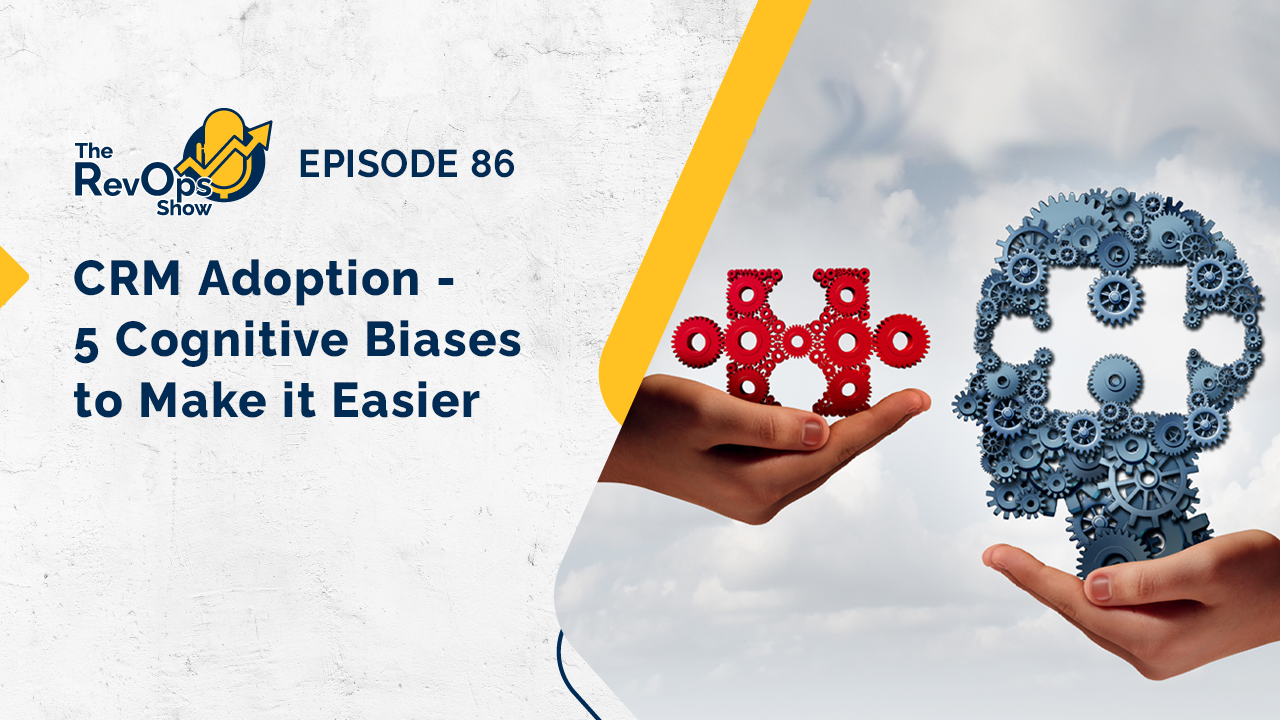Behavioral science can be used anywhere in business. We’ve seen it in previous episodes around sales and decision-making. Today Jess switched up the focus to look at utilizing 5 behavioral science concepts to drive adoption and utilization within a system.
Audio:
Video:

Additional Resources:
- [Blog] 7 Cognitive Biases that Influence Buyer Behavior and Decision-Making
- [RevOps Show] Episode 47: RevOps & Behavioral Science - 3 Key Principles that Effect Business Processes
- [RevOps Show] Episode 68: The Behavioral Science Behind Decision Making - Insights from 6 Psychological Concepts
- [RevOps Show] Episode 73: Behavioral Science Concepts - The Unseen Influences Shaping Your Sales Process
- [RevOps Show] Episode 77: Always Be Launching - The Key to CRM Success
- [Book] Atomic Habits by James Clear
Show Notes:
Pre-Show Banter:
- Even when they try to not record on Fridays, Doug and Jess somehow always make it back to a Friday recording.
- With it being Friday morning, Jess is still drinking her big cup of coffee, though she’s had enough to not violate her rule of, “Don’t talk to me until I’ve had my coffee.”
- Doug believes the best musical of all times is “Damn Yankees.” Jess would claim otherwise.
- Doug’s New Years is coming up as he’s looking forward to Opening Day of baseball season.
- Doug throws in a dad joke, per usual. “Canada is one of the wettest countries in the world, but it’s most famous export is Canada Dry.”
5 Behavioral Science Concepts Related to Adoption and Utilization Within a System
1. Honesty
When we work with clients we talk about how all progress begins with honesty. We’re going to be honest with them. They have to be honest with us. If there is no honesty, that’s where things will start to go off the rails and fail. There’s a saying, “Don’t piss on my back and tell me it’s raining.” Be open. Be honest. When you’re not clear and when you don’t provide a balanced perspective, you set up false expectations. If you’re hiding, then others will hide.
There’s also a difference between the perception of honesty versus real honesty. The unfortunate thing about honesty is the issue isn’t really about how honest you are, it’s how honest are you perceived to be. Honesty slows you down, but it shortens the path.
2. Habit
Build routines. Train on motions. How are we taking the user where we want them to take action? How can we build those habits instead of asking them to take the first step? This ties to a future concept - nudge. Everyone already has habits, it’s important to understand those habits and play into them.
There’s a term that James Clear used in his book Atomic Habits called habit stacking. “Habit stacking is a special form of an implementation intention. Rather than pairing your new habit with a particular time and location, you pair it with a current habit.” This is why you re-launch in an implementation and treat the initial launch as a start line.
3. Nudge
Nudges are not mandates. It’s like putting fruit at eye level is a nudge to get you to eat healthy. A nudge is a way to initiate a habit. It makes the thing you want to do a little easier and the thing you don’t want to do a little harder.
Nudges keep your agency. As humans, our brains are lazy, so a nudge actually feeds into our tendency for inaction.
4. Herd Behavior
Herd behavior is, “If I do what everyone else is doing, I might be foolish, but no one will notice.” That’s why the middle feels safe and in some cases is safe. There’s a rule of three here that says if three people are doing something, it no longer feels weird to be doing it. Being the odd person out feels scary, so we go with the flow of everyone else.
This is where the idea of piloting and having an initial launch group can help in an implementation. This group helps to make things safe for the rest of the group to move forward.
5. Incentives
Incentives can backfire. Things like monetary incentives, performance incentives, and mandate incentives fall into this group. These items are actually disincentives. More often than not, monetary or mandate incentives don’t seem to work.
The first problem is, if you think you know what the incentive is, you’re fooling yourself. The best incentive you can do is to create clarity around the achievement and the outcome so that people are pulling in the right direction.
The biggest incentive is, “What’s the score?” We think sometimes that the score is the incentive, but it’s all the other things behind it. Do we act in accordance with the incentive? There is no right or wrong incentive - they’re a mix and it’s dependent on what the situation is.
Jess’s Takeaways:
- All progress begins with honesty. It’s just as much about how you deliver the message as it is about what the message is.
- Stacking habits feed into a lot of things outside of just habits.
- Build the incentive around the achievement and the outcome. Make sure you’re aligned when you’re talking about those things.
Next Steps:
-
Follow Jess, Doug & Lift on socials for updates on the show or other insights:
-
Subscribe to the show on Spotify & Apple Podcasts
-
Check out Let's Play RevOps on Twitch for more commentary on this topic
